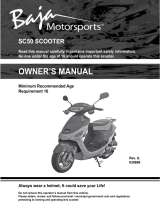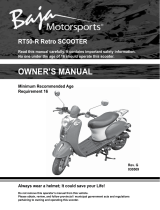
Page 2
Table of Contents
Safety Notes ...............................................................................................................................................................3
Additional safety tips:.................................................................................................................................................6
Vehicle Identification Numbers .................................................................................................................................7
Controls, Switches & Feature Locations....................................................................................................................7
Engine Stop Switch (5)...............................................................................................................................................8
Manual choke lever (9)...............................................................................................................................................8
Throttle lever..............................................................................................................................................................8
Front and Rear Brakes................................................................................................................................................9
Parking Brake.............................................................................................................................................................9
Safety Tether Switch ..................................................................................................................................................9
Remote Stop/Start Switch...........................................................................................................................................9
Fuel Tank..................................................................................................................................................................10
Fuel Valve ................................................................................................................................................................10
Inline Fuel Filter.......................................................................................................................................................11
Engine Oil.................................................................................................................................................................11
Checking the engine oil level...........................................................................................................................11
Changing the engine oil...................................................................................................................................12
Transmission ............................................................................................................................................................12
Gear Changing.................................................................................................................................................12
Changing the transmission oil..........................................................................................................................13
To change the Transmission oil on your E-TON engine, follow these steps:..........................................................13
Tires and Wheels......................................................................................................................................................15
Tire & Wheel Inspection..................................................................................................................................15
Tire Pressure....................................................................................................................................................15
Spark Plug ................................................................................................................................................................15
Exhaust System Maintenance...................................................................................................................................15
Muffler Cleaning .............................................................................................................................................15
Spark Arrestor Screen......................................................................................................................................16
Air Filtration System................................................................................................................................................16
Air Filter Maintenance.....................................................................................................................................16
To clean the filter.............................................................................................................................................16
Braking Systems.......................................................................................................................................................17
Front Brake System Inspection........................................................................................................................17
Brake Adjustment............................................................................................................................................17
Rear Brake System Inspection.........................................................................................................................18
Fill Master Brake Cylinder Reservoir..............................................................................................................18
Purging Brake Lines ........................................................................................................................................19
Drive Chain ..............................................................................................................................................................19
Chain Slack Adjustment ..................................................................................................................................19
Throttle Lever...........................................................................................................................................................20
Adjusting the throttle cable..............................................................................................................................20
Electrical Battery......................................................................................................................................................20
Pre-Operation Inspection..........................................................................................................................................21
Starting Procedure....................................................................................................................................................21
Driving your ATV....................................................................................................................................................21
Turning your ATV....................................................................................................................................................22
Parking Your ATV...................................................................................................................................................22
Specifications .................................................................................................................
..........................................23
Maintenance Schedule
..............................................................................................................................................25
Owners Maintenance Records..................................................................................................................................28
Wire diagram Viper 70M (RXL-70M).....................................................................................................................29
Wire diagram RXL-90R...........................................................................................................................................30
Warranty...................................................................................................................................................................31
Owner’s Notes:.........................................................................................................................................................33
Copyright ©2008-2009 ETON America, all rights reserved.

























